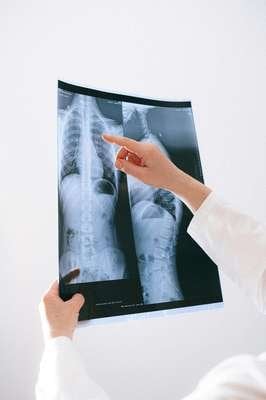Uncover the Silent Killer: The Unexpected Clue to Solving Non-Smokers' Lung Cancer Puzzle!
By
Danielle F.
- Replies 9
The enigma of lung cancer in non-smokers has long baffled medical experts, but recent research is shedding light on a silent threat that could be a key piece of the puzzle. It turns out that tiny air pollution particles, invisible to the naked eye, may be significantly increasing the risk of lung cancer in individuals who have never lit a cigarette.
The traditional image of lung cancer patients as smokers is being challenged by alarming statistics. While smoking remains the most significant risk factor for lung cancer, an estimated 6,000 non-smokers succumb to the disease each year. As smoking rates decline, we're seeing a perplexing rise in lung cancer cases among young women and non-smokers. In the UK, the incidence of lung cancer in never-smokers doubled from 2008 to 2014, and similar trends are being observed globally.
A groundbreaking 2023 report by the American Cancer Society revealed that more women aged 35 to 54 are being diagnosed with lung cancer than men in the same age bracket. In the United States, lung cancer doctors are reporting an increasingly younger patient demographic, which raises the question: What's behind this disturbing trend?
Researchers at the British Columbia Cancer Research Institute in Vancouver, Canada, embarked on a mission to find answers. They meticulously collected data from 255 lung cancer patients who had never smoked, tracing their residential history back to birth. By analyzing levels of pollution at their home addresses using satellite data, air pollution forecasts, and ground measurements within a 10-kilometer radius, the researchers pieced together a pattern of exposure dating back to 1996, when accurate air pollution information first became available.
The focus of the study was on particulate matter smaller than 2.5 micrometers, known as PM2.5. These soot particles, emitted from car exhausts, wood burning, and even smoking, can penetrate deep into the lungs and enter the bloodstream. The International Agency for Research on Cancer (IARC) classified outdoor air pollution and PM2.5 as Group 1 carcinogens in 2013, confirming their role in causing lung cancer.
The Canadian team's findings were startling. Women exposed to PM2.5 for at least three years were more likely to develop a DNA mutation called an EGFR mutation, regardless of their smoking status. This mutation accelerates the activity of the epidermal growth factor receptor (EGFR), leading to rapid cell division and, ultimately, cancer. Patients diagnosed with stage four lung cancer were far more likely to have these mutations. Interestingly, this association was not found in men who never smoked.
The implications of these findings are profound. They suggest that recent exposure to PM2.5 could have a significant impact on lung cancer risk in non-smokers, particularly among women. This discovery could explain why non-smokers are being diagnosed with a disease predominantly associated with smoking.
Symptoms of lung cancer, such as a persistent cough, chest infections, and aches in the chest or shoulder, often go unnoticed until the disease is advanced. While smoking accounts for approximately 70% of cases, other risk factors include exposure to radon gas, certain chemicals, and a family history of lung cancer. Although lung cancer is rare in individuals under 40, it's crucial to recognize that air pollution could be a contributing factor to the 2,300 new cancer cases in young people in the UK each year.
The study authors emphasize the need for further research to assess air pollution as a lung cancer risk factor. As we continue to unravel the mysteries of lung cancer in non-smokers, it's clear that the air we breathe plays a more significant role than previously thought.
For our members at the Seniors Discount Club, this research underscores the importance of being aware of the air quality in our environments. While we may not be able to control the air outside, there are steps we can take to improve the air quality in our homes, such as using air purifiers and ensuring proper ventilation.

We invite you to share your thoughts and experiences. Have you or someone you know been affected by lung cancer despite never smoking? How do you manage the air quality in your home? Your insights could be invaluable to others in our community. Let's continue the conversation in the comments below and work together to raise awareness about this silent killer.
The traditional image of lung cancer patients as smokers is being challenged by alarming statistics. While smoking remains the most significant risk factor for lung cancer, an estimated 6,000 non-smokers succumb to the disease each year. As smoking rates decline, we're seeing a perplexing rise in lung cancer cases among young women and non-smokers. In the UK, the incidence of lung cancer in never-smokers doubled from 2008 to 2014, and similar trends are being observed globally.
A groundbreaking 2023 report by the American Cancer Society revealed that more women aged 35 to 54 are being diagnosed with lung cancer than men in the same age bracket. In the United States, lung cancer doctors are reporting an increasingly younger patient demographic, which raises the question: What's behind this disturbing trend?
Researchers at the British Columbia Cancer Research Institute in Vancouver, Canada, embarked on a mission to find answers. They meticulously collected data from 255 lung cancer patients who had never smoked, tracing their residential history back to birth. By analyzing levels of pollution at their home addresses using satellite data, air pollution forecasts, and ground measurements within a 10-kilometer radius, the researchers pieced together a pattern of exposure dating back to 1996, when accurate air pollution information first became available.
The focus of the study was on particulate matter smaller than 2.5 micrometers, known as PM2.5. These soot particles, emitted from car exhausts, wood burning, and even smoking, can penetrate deep into the lungs and enter the bloodstream. The International Agency for Research on Cancer (IARC) classified outdoor air pollution and PM2.5 as Group 1 carcinogens in 2013, confirming their role in causing lung cancer.
The Canadian team's findings were startling. Women exposed to PM2.5 for at least three years were more likely to develop a DNA mutation called an EGFR mutation, regardless of their smoking status. This mutation accelerates the activity of the epidermal growth factor receptor (EGFR), leading to rapid cell division and, ultimately, cancer. Patients diagnosed with stage four lung cancer were far more likely to have these mutations. Interestingly, this association was not found in men who never smoked.
The implications of these findings are profound. They suggest that recent exposure to PM2.5 could have a significant impact on lung cancer risk in non-smokers, particularly among women. This discovery could explain why non-smokers are being diagnosed with a disease predominantly associated with smoking.
Symptoms of lung cancer, such as a persistent cough, chest infections, and aches in the chest or shoulder, often go unnoticed until the disease is advanced. While smoking accounts for approximately 70% of cases, other risk factors include exposure to radon gas, certain chemicals, and a family history of lung cancer. Although lung cancer is rare in individuals under 40, it's crucial to recognize that air pollution could be a contributing factor to the 2,300 new cancer cases in young people in the UK each year.
The study authors emphasize the need for further research to assess air pollution as a lung cancer risk factor. As we continue to unravel the mysteries of lung cancer in non-smokers, it's clear that the air we breathe plays a more significant role than previously thought.
For our members at the Seniors Discount Club, this research underscores the importance of being aware of the air quality in our environments. While we may not be able to control the air outside, there are steps we can take to improve the air quality in our homes, such as using air purifiers and ensuring proper ventilation.
Key Takeaways
- Researchers have unearthed that tiny particles of air pollution, such as those emitted from car exhausts and burning wood, may increase the risk of lung cancer in non-smokers, particularly women.
- EGFR mutations, which are known to trigger lung tumors, were found to be more likely in women exposed to PM2.5 particles, regardless of smoking status.
- The study showed an alarming trend of lung cancer cases increasing in young women and non-smokers, with a notable rise in the UK between 2008 and 2014.
- Further research is necessary to fully assess air pollution's role as a risk factor for lung cancer, but current findings highlight the potential impact of PM2.5 exposure on the disease, especially among non-smoking women.








